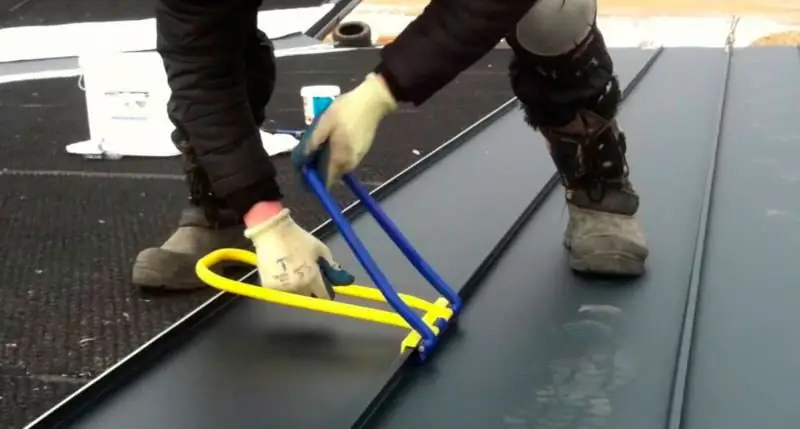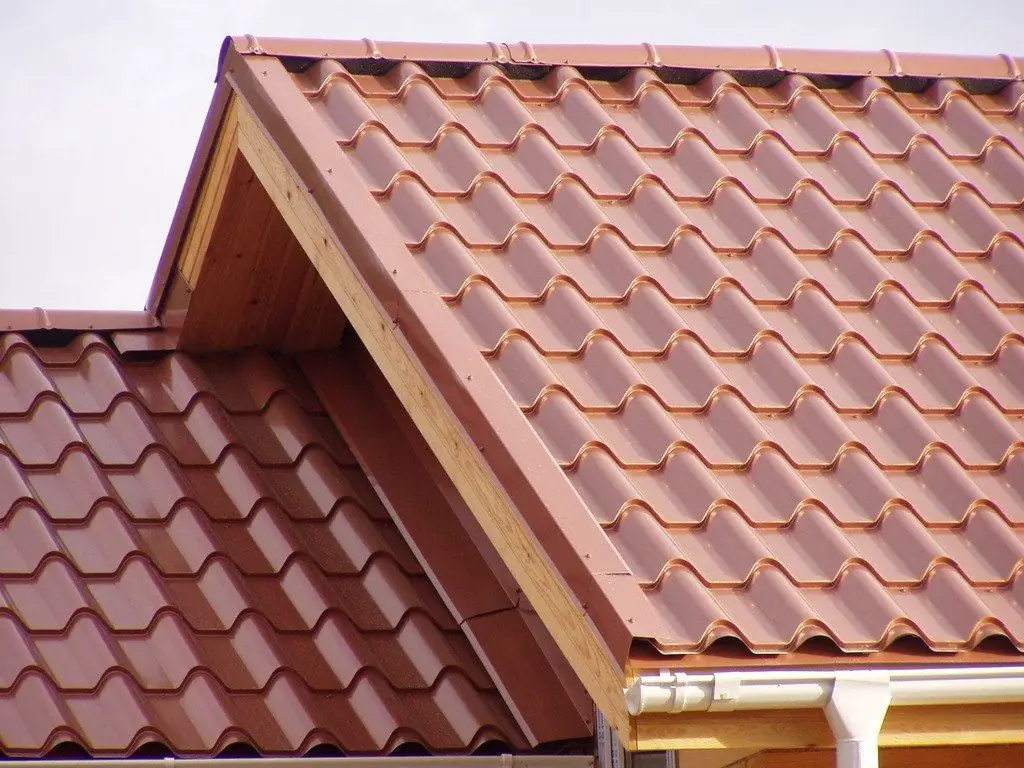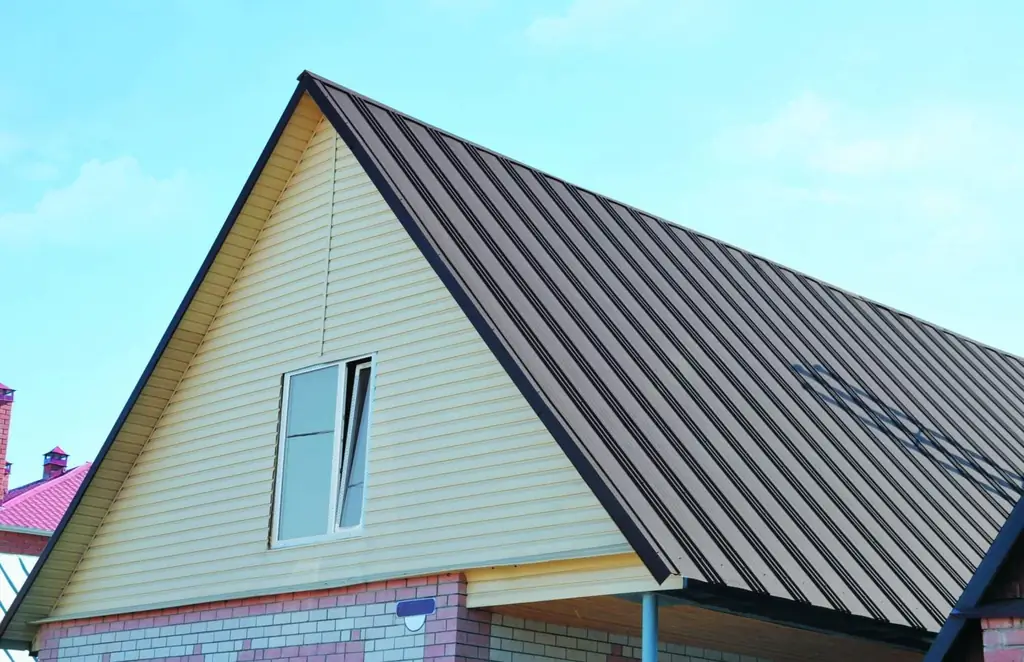
Table of contents:
- Author Bailey Albertson [email protected].
- Public 2023-12-17 12:53.
- Last modified 2025-06-01 07:32.
Types of roofing tools and features of its choice

Before you start building a new roof or start repairing an old covering, you need to select the necessary roofing tools. Hardware stores have a large selection of manual, semi-automatic and electrical accessories. Their choice is carried out in accordance with the type of material with which you plan to work. Even if you will not be laying the roofing material yourself, it is worth knowing what tools are used for this. Having the appropriate knowledge and assessing the availability of the appropriate equipment at the construction team, you can conclude how quickly and efficiently the work can be done.
Content
-
1 Types of roofing tools
-
1.1 Hand-held roofing tool
- 1.1.1 Closing frames
- 1.1.2 Video: Frame for closing the fold
- 1.1.3 Shears for metal
- 1.1.4 Roofing pliers
- 1.1.5 Mallets
- 1.1.6 Mandrels
- 1.1.7 Hammers
- 1.1.8 Knives
- 1.1.9 Squares and rulers
- 1.1.10 Oil shale tool
-
1.2 Semi-automatic roofing tool
- 1.2.1 Semi-automatic seamer
- 1.2.2 Bending machines
- 1.2.3 Presses
-
1.3 Electric roofing tool
- 1.3.1 Electric folding machine
- 1.3.2 Video: Electric Folding Machine
- 1.3.3 Electric metal shears
-
-
2 How to make a roofing tool yourself
- 2.1 Do-it-yourself mallet
- 2.2 Do-it-yourself roof burner
-
2.3 Safety measures
2.3.1 Video: how to make a roof burner yourself
- 3 How to choose the right roofing tool
- 4 Reviews of roofing tools
Types of roofing tools
The roof of any building is one of its most important elements. In order to cover it qualitatively, the skill of the roofer alone will not be enough, you must have the appropriate tools. They are:
- manual. They are easy to work with polymer coatings, roofing copper, galvanized steel;
- semi-automatic. Such equipment is used when installing panels with a large length;
-
electrical. They are used for working with sheet or roll materials. With the help of roll forming machines, which are easily and quickly reconfigured, cassette profiles and channels, cable trays, etc. are created.

Hand Roofing Tools A professional roofer should have around 40 special tools
Manual roofing tool
The most common is the hand held roofing tool. This is due to the fact that its cost is much lower than that of semi-automatic or electrical equipment. In addition, hand tools are suitable for both professionals and beginners who plan to carry out routine roof repairs or cover the roof of a small building.
Closing frames
Roof frames are used to close the rebate when installing a folded roof. For their manufacture, high-quality high-alloy steel is used, which ensures high durability of the tools. To improve the sliding process, stainless steel is used, and in order not to damage the protective coating of the roofing material during operation, a special bronze alloy is used.
There are frames with which the double standing seam is closed in two passes. To do this, use the frame numbered 1 and 2. Use them in turn, first go through the first number, and then use the frame number 2.

The manual frame for closing the fold has high strength, as it is made of high-alloy steel
You can purchase a universal frame, the peculiarity of which is that the first and second fold folds are performed with one tool. With the help of manual roof frames, you can work with copper or galvanized sheets, with the metal thickness up to 0.7 mm and the rebate height from 25 to 35 mm. The weight of a set of two frames is about 4.8 kg, so it is not difficult to work with such a tool.
The process of performing work with the frame for closing the fold consists of three stages.
- Laying of roofing material.
- Passage by means of frame No. 1, while the large fold is folded by 90 °.
- Passage using frame No. 2, after which a double standing seam is obtained.

To obtain a double standing seam, you need to make two passes with frames with a different profile
To reduce the effort required to fold the fold, some frames have the ability to adjust the length of the handles.
Video: frame for closing the fold
Metal scissors
For cutting the roofing material, metal shears are used. With their help, you can work with hard metal up to 1.5 mm thick and soft metal up to 2.5 mm thick. In the latter case, choose straight or curly scissors.
By the type of execution, metal scissors are:
-
single-lever. In appearance, they resemble ordinary household ones, but their constituent elements are connected in close proximity to the blade. If in household scissors the effort is applied with the fingers, then here the person acts with the whole palm, which makes it quite easy to cut metal. When working with such a tool, it is necessary to apply force both during the working stroke of the tool and when returning the handles to their original position. In some models, a coil spring is installed, with which the scissors open themselves, but it often pops out. In order not to injure the fingers, a small distance remains between the closed handles of the scissors;

Metal scissors Single-arm metal scissors look like ordinary scissors
-
with double linkage. Such a tool has a more complex design - the blades are not connected directly, but using a hinge mechanism. They have an expanding spring, but it is hidden in the handle and works more efficiently than in the previous version. This design allows less effort to be applied while cutting.

Double lever scissors The double-lever scissors make the job much easier
Metal scissors can have standard, shortened or extended blades. The cutting edge can be left or right, but the latter is most often used.
Pelicans are used to work with thick metal. Their peculiarity is that, unlike standard models, in which both blades are the same, here one part is made more massive. This allows you to cut without bending metal edges, so work gets done faster.
Depending on the model, the length of the cutting part can be from 50 to 130 mm, the length of the scissors is from 180 to 400 mm.
Roofing pliers
When carrying out roofing work, you can not do without tools such as pliers. With their help, bending of edges, the formation of individual parts and other work on laying roofing material, creating chimneys, ventilation pipes, installing and dismantling gutters, etc. are performed.
Roofing pliers are highly durable, as they are made by forging from high-alloy steel, after which additional hardening of the working surface is carried out
There are several types of roofing pliers:
-
straight lines. They are used to create seam roofs and have wider sponges than conventional tools, so the likelihood of damage to the material is reduced, and work is faster;

Straight roofing pliers Straight roof pliers can be used as clamps or to close the rebate
-
curved. With their help, you can form a fold, as well as make bends, edging ridges and other work, and it is convenient to work with them in hard-to-reach places.

Curved roofing pliers Roofing pliers can be bent at 45 and 90 degrees
Depending on the model, the bending angle can be 45 or 90 degrees, the width of the working part can also change.
Mallets
Mallets are a percussion tool that every self-respecting roofer should have. They are used to create complex roof structures. The main requirement for a mallet is that the working surface should be flat and smooth, and the material of the striker is softer than the material with which the work is performed.
There are several types of roofing mallets:
- round;
- wedge-shaped;
- rectangular;
-
with a beveled handle.

Roofing mallet Roofing mallet can have a wooden, rubber or plastic head
Mallets can be of different sizes, their working part can be plastic, wooden or rubber.
Mandrels
Roofing mandrels must be used together with a mallet or hammer. During the formation of the fold with the help of a mallet or when performing other work, the mandrel is placed on the back side and supports the material on which the blows are applied. The working prisms of the mandrels are made of hardened steel.
Mandrels are:
-
ridge - they form folded seams;

Ridge roof mandrel A ridged mandrel is used to form folds
-
angular - they are needed to form abutments;

Angle mandrel The corner mandrel is used to form semicircular corner joints
-
in the form of a paddle - they form and close folded locks;

Roofing mandrel-blade Paddle-shaped mandrel is used for seam lock device
-
type "heron" - used to form folds and envelope joints;

Heron roof mandrel The “heron” frame is used to form the corners of the “envelopes”
-
round - with such a tool they perform curly bends for abutments and radius elements of metal roofs.

Round roof mandrel A round mandrel is used to form corner abutments and radius elements of a seam roof
Hammers
With the help of a roof hammer, it is convenient not only to hammer in nails, but also to pry on boards, make holes, trim the sheathing, and chop soft materials. The work can be done with one hand, while the other remains free.
All the described qualities of the roof hammer are explained by the peculiarity of its design. One part of it is the same as that of a regular one, and the other is made in the form of a nail-pusher, but one spike is slightly shorter than the other.

Roof hammer has one shorter nail than the other
In order for the hammer to serve for a long time, its firing pin is made of chrome vanadium steel, after which high-temperature hardening is performed. The handle can be made of wood, metal or fiberglass - a durable and lightweight material that does not rot, deform or conduct electricity.
Depending on how much effort you plan to apply with the hammer, its weight is selected. If the efforts are small, then a model weighing 250-500 g is sufficient, otherwise it is necessary to purchase hammers weighing 600-900 g.
Knives
When cutting soft roofing materials such as roofing felt or shingles, a roofing knife is required. Its peculiarity is that the blade is shaped like a hook. A set with a knife usually comes with trapezoidal cutting elements, so hooks must be purchased separately. The double-sided hook blade is the best choice for shingles. After one side is dull, it can be turned over, so its lifespan is twice that of a regular one.

The roofing knife can have either a hook or a trapezoidal blade
Almost all roof knives have the same design. The blade can be hidden or not - it is better when it is retractable, since such a knife can be safely carried in a pocket. Some craftsmen do not like retractable blades, as they can become clogged with stone chips.
Squares and rulers
To perform measurements and carry out the correct cutting of materials, you cannot do without a ruler and square. The roof square is made of polished and varnished steel.

The roofing square is made of steel, therefore it has high strength
To facilitate the work, reversible scales are made - since when performing roofing work, very high accuracy is not needed, the scale graduation is 2 mm. It has large markings, so it is easy to use the square even in cloudy weather or in poor lighting. For measurements, metal rulers or tape measures can be used.
Slate tool
The following hand tools can be used to work with slate.
-
Shale hammer. This tool has the appearance of a long, pointed nailer. Using a power tool, you cannot get the characteristic factory texture of slate, so a special hammer is used to give the tiles 3-5 mm thick the required shape. Adjustment of the roofing material is carried out during its installation. The holes for fastening the slate are also made with the pointed end of the hammer. This creates a tapered hole, which significantly reduces the likelihood of damage to the slate by the nail head.

Shale hammer Using a slate hammer, you can adjust the roofing material to the desired size and make holes in it
-
Anvil. It must be used in conjunction with a hammer and is necessary to obtain an even chip and punch holes. After marking, the tiles are laid on the anvil, and then its protruding part is separated by a sharp movement of the hammer. The incus can be straight or curved.

Slate anvil Slate anvil can be straight or curved
-
Cutter. This tool is used to neatly trim 4-6 mm slate. The cutter can be optionally equipped with a hole punch, which allows it to be used to create holes in slate plates.

Oil shale cutter The cutter is used to trim slate with a thickness of 4-6 mm
-
Crowbar. This tool is also called a crowbar. It is made of spring steel and is used to dismantle slate for roof repairs. On one side, the pry bar is sharpened, so it can be used to cut off the heads of nails that cannot be pulled out.

Slate pry bar The pry bar is made of spring steel and is used to dismantle slate
-
Guillotine. This tool is used when slabs thicker than 7 mm are to be trimmed. It is possible to fix the guillotine on the crate, so it will always be at hand.

Guillotine The guillotine is used for trimming slate with a thickness of 7 mm or more
Semi-automatic roofing tool
To simplify and speed up the roofing work, a semi-automatic tool is used. Its main advantages:
- high performance;
- less likelihood of damage to the protective polymer layer on the roofing material;
- the ability to customize equipment to work with metal of different thicknesses;
- high quality of the seam along its entire length;
- work efficiency when covering long slopes.
Semi-automatic seaming machine
The semiautomatic machine allows you to roll up the folds much faster and better than using frames. In this case, as with frames, there are two devices that must be used in turn.
The principle of operation of the seaming machine is quite simple: first, the device is put on the fold, after which the person pulls the machine by the handle and it rolls up the seam. The result is a high-quality and tight seam.

The semi-automatic seam sewing machine allows you to make seams much faster, but it still works in two passes.
It is most effective to use such machines when creating a roof from panels longer than 15 meters. The productivity of work in this case will be 3 times higher than when using a hand tool.
Bending machines
In order to create profiles from sheet material, bending machines are used. With their help, you can make various additional elements that make up the ventilation and drainage system, complex boxes.
When choosing a listogib, you need to pay attention to what thickness of metal it can work with and what permissible bending angle it provides. To perform roofing work, it is enough to purchase a mobile bending machine, and if you plan to create products of complex box-shaped shapes, you will need segmental equipment.
There is a certain classification of bending machines.
-
Manual machine. This equipment is intended for single and small-scale production, therefore it does not require special maintenance and qualifications. The roller knife allows you to cut sheet material directly on the construction site. The result is a product with clear angles and shapes, as well as a high-quality and even cut. With the help of a manual bending machine, you can work with thin-sheet profiles made of copper, stainless steel, brass, polymer-coated materials.

Manual bending machine Manual bending machine is used for single and small batch production
-
Listogib with an electromagnetic clamp. Here the workpiece is pressed with a special electromagnetic press. The listogib is controlled by a foot pedal, so the operator can perform work better and faster.

Listogib with an electromagnetic clamp The bending machine with an electromagnetic clamp allows you to work with a minimum expenditure of physical strength
-
Segment bending machine. It can be used to create complex box-shaped forms such as doors, facade cassettes, boxes and other non-standard products. Bending and pressure beams are easy to adjust, so equipment can be quickly reconfigured.

Segment bending machine Segment bending machine allows you to create complex box-shaped elements
-
Electromechanical bending machine. Such equipment is used in serial production. The bending and pressure beams are highly wear resistant. The control is carried out using an external pedal.

Electromechanical bending machine Electromechanical bending machine controlled by a foot pedal
Presses
The press can be used to cold bend metal in different directions and at different angles. This is a multifunctional equipment, therefore it is used both in construction and in other areas of production.
There are several types of presses.
-
Manual hydraulic press. It can be used to make metal elements with high precision and rigidity. Bending of sheet metal can be performed in any plane, which makes it possible to create roofing elements of high complexity. Working with a hydraulic hand press is easy as it requires minimal effort. When choosing such equipment, the maximum possible force is taken into account, as well as the size of the material with which such a press can work.

Manual hydraulic press Working with a manual hydraulic press requires minimal effort
-
Manual mechanical press. With the help of such equipment, you can not only bend metal, but also carry out forging, stamping and other similar operations.

Manual mechanical press Manual mechanical press allows not only bending metal, but also forging and stamping
Electric Roofing Tool
An electric roofing tool is popular with professional installers, since when using it, not only the roofing is quickly and efficiently installed, but also requires minimal physical labor.
Electric folding machine
The use of an electric folding machine allows you to minimize the cost of physical strength when creating a folded roof. High-quality and tight seam connection is carried out with minimal human intervention. The equipment is small, so it is fed directly to the roof, after which the engine is turned on and work begins.
The seam seam machine moves along the seam and performs an even closing of the double seam. All work is done in one pass. This not only saves the strength of the roofer, but also significantly increases the speed of work. When using manual or semi-automatic equipment, you need to make two passes, and this requires additional time.

The electric seam sealer automatically closes the double seam evenly
The use of electrical equipment allows you to work 5 times faster than hand tools. Such a machine has a productivity of about 15 m / min. If it is necessary to work with metal of different thickness, the equipment can be quickly reconfigured.
Video: electric folding machine
Electric shears for metal
It is very convenient to use electric scissors for cutting smooth or shaped materials. Some people may say that this can be done with a grinder, but it is not always possible to use it. When cutting metal with a protective coating, strong heating and damage to the top layer occurs, so the material quickly rusts later. In such situations, the use of an electric shears is an excellent solution.
If you need to cover a small roof, then you can do it with hand scissors, but for large volumes you need to purchase an electric tool. With its help, the process of cutting metal is greatly simplified and accelerated, it is convenient to make curved cuts.
There are several types of electric metal shears.
-
Leafy. With their help, you can perform straight or shaped cuts. They have two knives, but one is stationary, and the second is driven by an electric motor. It is possible to cut metal up to 4-5 mm thick, but work should only be started from the beginning of the sheet.

Electric sheet shears With electric sheet shears, you can make straight and shaped cuts
-
Cutting. The principle of operation is similar to that of a hole punch. They are good at cutting corrugated and profiled metal up to 10 mm thick. You can make sharp turns, and you can start work from any part of the sheet. It is this tool that is most popular with roofers.

Electric nibblers With the electric punching cutter, you can start cutting from any part of the sheet
-
Slotted. This is a versatile equipment with which it is easy to make curly cuts, but chips appear during work. Work can be started anywhere on the sheet, while its thickness should be up to 2 mm.

Slotted electric scissors With the help of electric slotted scissors, it is convenient to make curly cuts
Electric scissors can be mains powered or battery powered. The latter are highly mobile, but they are less powerful and are usually designed to work with material that does not exceed 2 mm thick.
How to make a roofing tool yourself
As already mentioned, roofing tools are made from high strength alloy steels. In order to prevent the frames from scratching the polymer coating, their working surfaces are often made of a bronze alloy. The mandrels are cast from hardened steel, after which the surface is polished with high quality. Therefore, making them at home will not work. It will also not be possible to make your own roofing hammer or pliers.
Do-it-yourself mallet
Of all the roofing tools at home, the easiest way is to make a mallet.
The manufacturing process will be as follows.
-
Selection of wood and creation of a mallet head. For this, oak, pear or birch wood is usually used, since it is hard and dense. Using a hand or electric saw, a workpiece with dimensions of 130x90x60 mm is cut out.

Mallet head blank The mallet head is made of hardwood
-
Creates a hole for the handle. In the center of the head of the mallet we make markings for the hole. For a secure attachment of the handle, it must be tapered. You can make a hole with a chisel.

Creating a hole for a handle A chisel is used to create a tapered hole
-
Handle making. Its thickness is about 20 mm, and its width is 30 mm, which corresponds to the size of the hole. Using a chisel, adjust the size of the handle.

Creating a handle The size of the handle is adjusted with a chisel
-
Connection of parts. It remains to connect the handle and the head of the mallet. If the dimensions of the hole and the handle do not match a little, a wedge of the appropriate size is driven into the gap formed.

Connecting parts If there is a gap between the handle and the head of the mallet, a wedge is driven into it
DIY roofing burner
Roofing gas burner refers to a hand-held tool that is used when making or repairing a soft roof. With its help, you can perform local heating of materials, dry the surface. In addition, it can solder metals with light-alloy solders, remove old paint, and heat materials to the required temperature.
Since the design of the roof burner is simple, you can do it yourself. First you need to select all the necessary elements.
-
The jet is the main working element with which the torch is formed. You can use jets from a carburetor or from a gas stove. It is recommended that the nozzle diameter does not exceed 0.8 mm.

Jet The jet can be taken from a car carburetor
- Glass. To make it, you need to have a thick-walled steel pipe with a diameter of 25-40 mm and a length of 100-150 mm.
-
Main pipe. The brass or copper tubing must be of the appropriate length. It will need to be threaded to install the nozzle.

A tube Trunk tube can be copper or brass
-
Regulating valve. A gas cock can be used to shut off the gas supply to the stove.

Gas valve To shut off the gas supply, you can use a special shut-off valve with a yellow handle
- Lever. It should be comfortable, the easiest way is to make it out of wood.
- Gas bottle and reducer. You won't be able to make them yourself, so you need to purchase them in the store.
The assembly process consists of several stages.
-
A thread is cut in a copper tube, after which a nozzle is screwed in and thus a nozzle is created.

Nozzle The nozzle is connected with a pipe by means of a thread, and a nozzle is obtained
-
A glass is made. To do this, on one side, the pipe is cut into 6 petals, the length of which is about 1/3 of the length of the glass, they are slightly bent and brought to the center. It turns out a cone through the holes of which air will flow to the nozzle. A tube is inserted between the petals, after which they are pressed against it and soldered.

Burner beaker Holes are made in the glass through which air will flow to the nozzle
-
Create the back of the burner. To do this, use two squeegees with a thread with a diameter of 25 mm. In the one-way squeeze from the side where there is no thread, insert and fix the main tube, and screw the valve to the second side. A double-sided squeegee is connected to the valve, to the other side of which an adapter is screwed to connect the hose from the cylinder. All connections must be well sealed, for which fum tape is used.

Fitting To connect the hose from the cylinder to the burner, a special fitting is mounted
-
Handle making. You can make it out of wood, or you can use an ax handle. The handle is attached to the squeegees with clamps, as this is the strongest part of the burner. When installing the handle, it is necessary that the valve is slightly in front, so it will be much more convenient to work.

Burner handle The burner handle is made of wood
-
Connection to the cylinder. It remains to connect the hose to the burner and to the cylinder reducer, after which the burner can be tested. On the adapters, the hose is securely fixed with clamps.

Reducer cylinder The cylinder is connected to the burner through a reducer
To start working, you need to open the valve on the cylinder, and then on the heater handle. A characteristic sound will appear from the jet, indicating gas movement. It is necessary to wait a little for the gas to squeeze out the air in the line, after which you can ignite the torch.
Security measures
It must be remembered that a gas burner is a source of increased danger, so work with it must be done carefully. Before using the burner, be sure to check the tightness of all connections.
During work, you must adhere to the following rules:
- there should always be a fire extinguisher nearby on the roof;
- it is impossible to work at night, there must be normal lighting;
- only one gas cylinder can be lifted to the roof during operation;
- the gas cylinder must not be heated.
Compliance with these simple rules guarantees the safety of roofing work using a gas burner.
Video: how to make a roofing burner yourself
How to choose the right roofing tool
There is a large selection of both hand and electric roofing tools. It should be borne in mind that tools that look identical can differ significantly in the quality of workmanship, therefore it is better to purchase them in specialized stores and give preference to trusted manufacturers.
When choosing an electric tool, you need to pay attention to its power and performance. In addition, you need to consider what kind of work you need it for. If these are one-time roofing works or they have small volumes, then manual devices are quite enough. In the case when you have to work on long slopes or roof installation is your professional activity, in addition to hand tools, you will have to buy semi-automatic and electrical equipment.

For repairs or small volumes of roofing work, it is enough to have hand tools
In addition to the described tools, auxiliary tools may be needed to perform roofing work:
- a jack or lifting mechanism, with the help of which the delivery of heavy elements to the roof of the building is carried out;
- brushes, spray gun, spatula - they are used during paint and varnish and priming works;
-
scribes - it is better to use them for marking metal products instead of a pencil;

Scraper for metal It is convenient to use a scribe with a tungsten tip for marking metal surfaces.
- center punch, it is used to apply marks on metal sheets, which serve for the convenience of drilling holes.
In the arsenal of a professional roofer, there should be about 40 tools, then he will be able to perform work quickly and efficiently and solve all the tasks that arise when creating a roof
If you decide to invite a contractor to create or repair a roof, be sure to ask about the technical equipment of workers. Thus, you will draw a conclusion about their qualifications and readiness to complete the assigned tasks, and you will be able to choose really professionals.
Reviews of roofing tools
If you are not a professional roofer, then you do not need to have all the tools described. Semi-automatic and electric cars are expensive, so you shouldn't buy them for a one-time roof covering. To repair the roof or cover the roof of a small building on your own, it is enough to have a set of hand tools. Now that you know what tools a professional should have, you will be able to assess his qualifications when choosing an artist to cover the roof of your house. This is easy to do, just look at the tools that he will use to get the job done.
Recommended:
Repair Of Metal Roofing, Including A Description Of Its Main Stages, As Well As Material And Tools For Work

Methods and materials for the repair of metal roofing. What tool is needed and step-by-step instructions for eliminating roof breakages
Straw Roofing, Including Its Structure, Installation And Operation Features, As Well As How To Do It Yourself

Characteristics of a thatched roof, its advantages, installation features. How to make a straw roof with your own hands. Operating rules and repair
The Slope Of The Roofing From The Profiled Sheet, Including How To Choose The Right Brand Of This Roofing Material, Depending On The Angle Of The Roof

What is the slope of the roof. The angle of inclination of the roof from the profiled sheet: minimum and permissible. The choice of the brand of corrugated board according to the degree of roof slope
How To Properly Wash Makeup Brushes, How Can You Wash Cosmetic Sponges (including For Foundation), How Often You Need To Do It

How often and correctly you should wash your makeup brushes and sponges. Home and professional cleaning tools for cosmetic tools. Instructions. Video
Why You Can't Why You Can't Wash Floors On Friday: Signs And Facts

Why you can't wash floors on Friday: signs and superstitions. The opinion of the mystics and Orthodoxy
